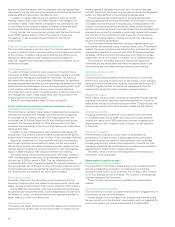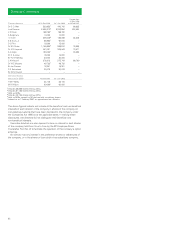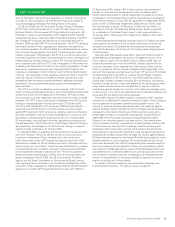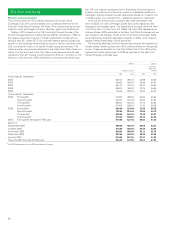BP 2006 Annual Report Download - page 79
Download and view the complete annual report
Please find page 79 of the 2006 BP annual report below. You can navigate through the pages in the report by either clicking on the pages listed below, or by using the keyword search tool below to find specific information within the annual report.
BP Annual Report and Accounts 2006 77
3. Executive limitations policy, which defines the boundaries on how the
group chief executive can achieve these results and requires that any
executive action taken in the course of business considers internal
controls, risk preferences, financing, ethical behaviour, health, safety,
the environment, treatment of employees and political considerations.
Accountability in our business
The group chief executive describes to the board how the expected
outcome and goals are intended to be delivered through regular business
plans, which also encompass an assessment of the group’s risks.
During the year, the board receives updates on progress towards these
outcomes through actual and forecasted results.
The group chief executive is obliged to review and discuss with the
board all strategic projects or developments and all material matters
currently or prospectively affecting the company and its performance.
This key dialogue specifically includes any materially under-performing
business activities, actions that breach the executive limitations policy
and material matters of a social responsibility, environmental or
ethical nature.
The board-executive linkage policy also sets out how the group chief
executive’s performance will be monitored and recognizes that, in the
multitude of changing circumstances, judgement will always be involved.
The systems set out in the board-executive linkage policy are designed to
manage, rather than to eliminate, the risk of failure to achieve the goals or
observe the executive limitations policy. They provide reasonable, rather
than absolute, assurance against material misstatement or loss.
The board: structure and skills
The board is composed of the chairman, nine non-executive and seven
executive directors. In total, four nationalities are represented on the
board. The names and biographical details of the directors are provided
on pages 65-66.
The board is actively engaged in orderly succession planning for both
executive and non-executive roles, to enable the board’s composition to
be renewed without compromising its continued effectiveness.
Lord Browne will retire as group chief executive and from the board
on 31 July 2007. Dr Tony Hayward will become group chief executive on
1 August 2007. Mr Michael Wilson stepped down from the board at
the end of February 2006 and Mr Michael Miles retired in April 2006.
Sir William Castell joined the board in July 2006. Mr Andy Inglis joined
the board on 1 February 2007 as chief executive of the exploration and
production segment in succession to Dr Hayward. At the 2007 AGM,
Mr John Bryan will retire from the board.
The efficiency and effectiveness of the board are of paramount
importance. Our board is large but this is necessary to allow both
sufficient executive director representation to cover the breadth and
depth of the group’s business activities and sufficient non-executive
representation to reflect the scale and complexity of the company and to
staff our board committees. A board of this size also allows systematic
succession planning for key roles.
We believe that our non-executive directors bring a broad range
of relevant skills and experience to the work of the board and its
committees. Not only do they contribute international and operational
experience, but they also provide an understanding of the economies and
world capital markets in which the group operates and an appreciation of
the health, safety and environmental and sustainability issues the group
faces. Our executive directors bring a further perspective to the work of
the board through their deep comprehension of the company’s business.
Board independence
Part of the qualification for board membership of BP is the requirement
that non-executive directors be free from any relationship with the
company’s executive management that could materially interfere with the
exercise of their independent judgement. In the board’s view, the non-
executive directors fulfil this requirement and the board has determined
that those who served during 2006 were independent. All non-executive
directors are now subject to annual election and to date have received
overwhelming endorsement at successive AGMs.
Sir Ian Prosser joined the board in 1997. It is the view of the board that,
despite having served for more than nine years, he remains independent.
His experience and long-term perspective on BP’s business have provided
a valuable contribution to the board, given the long-term nature of our
business. The board has specifically requested that he remain chairman
of the audit committee for the time being through the retirement of
Dr Byron Grote.
Those directors who joined the BP board in 1998 after service on the
board of Amoco Corporation (Messrs Bryan, Massey and Davis) are
considered independent since the most senior executive management
of BP comprises individuals who were not previously Amoco employees.
While Amoco businesses and assets are a key part of the group, the
scope and scale of BP since its acquisition of the ARCO, Burmah Castrol
and Veba businesses are fundamentally different from those of the
former Amoco Corporation.
The board has satisfied itself that there is no compromise to the
independence of those directors who serve together as directors on the
boards of outside entities (or who have other appointments in outside
entities). Where necessary, our board ensures appropriate processes are
in place to manage any possible conflict of interest.
Board directors: terms of appointment
The chairman and directors of BP stand for re-election each year and,
subject to BP’s Articles of Association, serve on the basis of letters
of appointment. Executive directors of BP have service contracts with
the company. Details of all payments to directors are reviewed in the
directors’ remuneration report on pages 68-75.
BP’s policy on directors’ retirement is as follows: the service contracts
of executive directors are expressed to expire at a normal retirement age
of 60 (subject to age discrimination), while non-executive directors
ordinarily retire at the AGM following their 70th birthday. It is the board’s
policy that non-executive directors are not generally expected to hold
office for more than 10 years.
In accordance with BP’s Articles of Association, directors are granted
an indemnity from the company in respect of liabilities incurred as a result
of their office, to the extent permitted by law. In respect of those liabilities
for which directors may not be indemnified, the company maintained a
directors’ and officers’ liability insurance policy throughout 2006. This
policy has been renewed for 2007. Although their defence costs may be
met, neither the company’s indemnity nor insurance provides cover in the
event that the director is proved to have acted fraudulently or dishonestly.
Board and committees:
meetings and attendance
The board requires all members to devote sufficient time to the work
of the board to discharge the office of director and to use their best
endeavours to attend meetings.
In addition to the AGM (which 14 directors attended), the board met
nine times during 2006: six times in the UK, twice in the US and once
in Turkey. Two of these meetings were two-day strategy discussions.
A number of board committee meetings were held during the year;
for details of these and their attendance by board members please
see the following table.
























